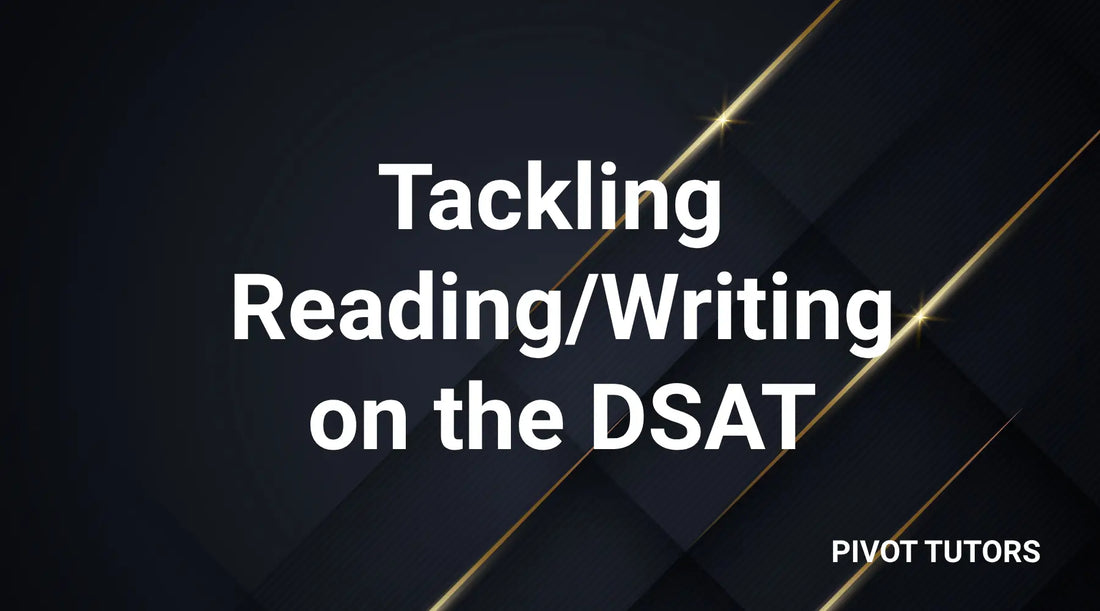By Saige Brown
With the SAT transitioning into a digital format, many students are left wondering how their approach to the new test style should change and adapt. While there are certainly similarities between physical and digital, there are a few key differences that change the way students need to go into the DSAT. Our blog has already covered the whole of the formatting changes as well as more specific ways to improve your math score, so now it’s time for the reading-writing (RW) section to get the same treatment! Read on for a rundown of the changes in the new digital RW medium as well as new question types and strategies to implement as you take the RW modules.
The Baseline
Both the SAT and the DSAT have a focus on reading comprehension and grammar choices. However, the DSAT places its emphasis on adaptive testing as opposed to static testing. Where before students all took the same test, now online the DSAT adapts to each user differently. For the physical SAT, there were two separate sections under the humanities category: the English section with a more grammatical focus and the reading section with a more comprehensive/inference-based focus. The digital SAT has done away with this separation, interspersing questions of all types with each other under the new cohesive reading-writing label. As a result, students are likely to see reading-based questions followed by questions focused on punctuation throughout the test. In this way, they can combine their knowledge of the separate concepts into one two-module section instead of something more distinct.
In addition, a few new question types have been added to the DSAT to balance out the ones that were cut. Gone are the page-long reading sections with chunks of questions relating to them. Instead, any reading comprehension questions have been relegated to one or two paragraphs to analyze at most. Thus, students are able to focus on answering one question at a time instead of connecting them to each other or anticipating something else related to their current subject. The need for annotation has become much less prominent, as the information given for each question is short enough to not require as much in-depth analysis via underlining, circling, or boxing. Instead, the test provides students with a highlighting tool in case they need to remember a crucial piece of information for any given question.
New Horizons
One entirely new concept, instead of a reworked one from the physical SAT, is that of rhetorical synthesis or “bullet point note” questions. As an example:
While researching a topic a student has taken the following notes:
- Not all big cats are considered to be “big cats.”
- Even if a cat-like animal is big, that does not automatically officially classify it as a “big cat,” technically speaking.
- Big cats must belong to the Panthera genus and have a special bone in their throats that allows them to roar.
- Only lions, jaguars, tigers, and leopards fit these specifications.
- This means even cougars, mountain lions, cheetahs, and pumas, though large in size, are not classed as “big cats.”
- These cats do not roar, they either meow, yowl, or purr, akin to house cats.
The test would then ask a question about what the student hopes to achieve, oftentimes inquiring about appropriately using key information to reach a goal. As an example:
The student wants to compare accurately classed “big cats” to cats that just happen to be large in size. Which choice most effectively uses relevant information from the notes to accomplish this goal?
In this case, (D) would be the correct answer, as it accurately compares the two cat-egories. (A) and (B) don’t work because they only explain big cats and non-“big cats” separately, they don’t compare the two. (C) makes a comparison, but it’s between the wrong subjects: wild cats and domesticated cats, instead of technically “big cats” and large-sized cats.
Tips!
These questions have never been presented in such a format before the DSAT, and as such, they have no previous material to look back on for reference. So, we’ve compiled a few ways to approach them that can prove useful for students planning to take the DSAT in the future.
- Read the question first!
Before you begin to read the bullet points, make sure to read the question first. Oftentimes there will be keywords you need to pay attention to, such as in our previous example with the word “compare.” That word is crucial to understanding what the question may be asking of you.
- Look at the answers next!
Though this may seem counterintuitive, you’ll want to read the answers before you read the notes. Search for answers that do what the question requires. In the case of our example, looking through the answers, (C) and (D) are the only ones who make comparisons. As such, we can immediately rule out (A) and (B). Then, when we analyze the question, we notice that (C) is making the wrong comparison, so that makes it incorrect as well! This only leaves us with (D).
- Now look at the notes!
Now that you have an answer that you feel does what the question is asking of you, go back and check the notes to make sure the information is accurate to the choice you’ve made. For our example, everything in (D) checks out so you can feel confident in picking it and moving on to the next question.
To conclude…
As we continue to learn more about the DSAT, through taking it and studying it, we will be sure to provide more information on strategies and questions that students need clarification on. In the meantime, check out our other blog posts on the DSAT to stay up to date on all the latest tips and tricks we can provide!

